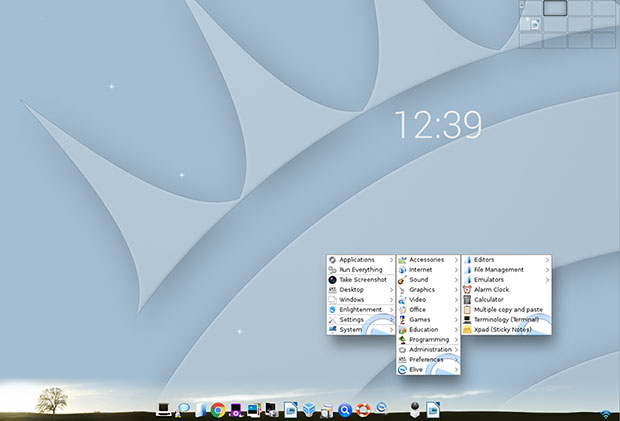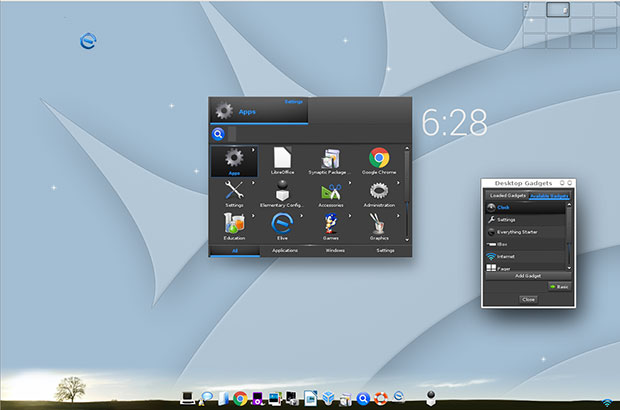Elive Elevates Linux With Enlightenment
![]()

The Elive distro's integration of the Debian Linux base and the Enlightenment desktop is a powerful combination. Together, they offer a unique computing platform that is powerful and flexible.
Elive is not like most Linux distributions today. It does not have a team of workers supporting multiple desktop offerings cranking out frequent upgrades each year. It also does not have a thriving community.
In fact, Elive is one of a few Linux distros that aggressively asks for donations in order to download the installation ISO file. You can get the download without donating, but the process requires you to verify your email address and wait for the download link.
Elive first appeared in January 2005. The second stable version came in 2010. Eight years later the third stable version arrived, version 3.04.
Developer Samuel F. Baggen announced the release of version 3.05 on April 29. It is based on Debian 7 "Wheezy," with a customized Enlightenment 17 desktop.
The customization is key to what gives Elive the edge over the few other distros running the latest version of Enlightenment, which is E22. However, this latest Elive version is likely the last update in the Elive 3 series.
The developer is focused on the next release, which will be based on Debian 10 "Buster." That release could be well in the future, though, because donations from users have not been sufficient to support the developer's continued efforts so far.
The silver lining is that this latest Elive release is updated with some of the internal improvements Baggen developed for the next version of Elive. So this latest release provides an early look at what may be coming next.
Elive is a fast and very configurable Linux OS that has an unusually pleasing appearance. It is designed to run fast on older computers with more modest hardware specs. It is blazingly fast on newer computers with more memory and better graphics circuits.

Screen gadgets and a macOS-style dock provide a modern and speedy look and feel for a stable Linux platform.
- click image to enlarge -
Debian and E17 Worthy Marriage
It is refreshing to see the union of Debian and Enlightenment 17 as the foundation for Elive. Typically, you see more distros built upon Ubuntu or Linux Mint, which themselves are based on Debian Linux.
Debian developers tend to be more cautious with package upgrades, making it a bit more stable and less bleeding edge. Enlightenment 17 is known for its artistic design quality and its keen support for older hardware.
In its infancy, Enlightenment started out as a window manager for Linux/X11. It grew into a suite of 10 core libraries to create beautiful user interfaces with much less work. Each library fulfills a purpose, and all are not required in every distro integration.
The Enlightenment desktop's use is not as widespread as more popular and older environments. So the learning curve is steep for new adopters, no matter which flavor of Linux or Microsoft Windows they previously used.
It is not that E17 is overly difficult to learn -- it is simply different. The lack of similarity to other desktops means that even more experienced Linux users have to acclimate themselves to what can be a jarring experience.
Elive does a good job of simplifying the first steps of using E17. It presents a workable basic configuration. It has enough applications pre-installed to let you get work done or explore the OS with less frustration than literally having to build from scratch.
Ample User Options
Like Debian-based Linux distros in general, Elive is fairly easy to install.
You can install if from a live CD/DVD. You can install it to a USB thumb drive and carry it with you as a portable Linux OS. Unlike most Linux live sessions on rewritable DVDs or on USB drives, Elive's live session provides a speedy environment that also comes with an option to create persistence.
Persistence set up on a USB drive is a very handy alternative to an actual hard drive installation. The persistent memory feature lets you add/remove software and keep configuration settings and saved data intact.
Either way -- full installation or portable persistence -- Elive includes an interesting collection of wallpapers. It has a gorgeous default theme that is superior to standard E17.
An added benefit is having a full inventory of applications out of the box. Just make sure that you include all the third-party applications made available during the installation process.
My one disappointment with the included software is the age of some of the packages. For example, the LibreOffice suite is the version 4.3.3 series. That predates the new user interface in the version 6.2.3 series.
Look and Feel
The Elive desktop view is beyond nice. It is uncluttered. It lacks a traditional panel bar. It does not have a main menu button.
The design of its menu system and user interface are very different. Perhaps the only elements bearing similarity to other desktop environments are a macOS-like dock and the ability to left- or right-click anywhere on the screen.
What, no menu button? Correct. Working without a traditional menu system and panel with applets takes getting used to.
No panel bar applets also means no virtual workspaces switcher tool. No, workspaces navigation is not done through awkward side panels like those in GNOME 3.
The upper right-hand corner of the screen has a very workable solution. A thumbnail-sized grid with 12 workspaces lets you move among virtual workspaces and move open application windows to other workspaces.

Elive's modified E17 desktop has a unique user interface that lacks traditional panels and menus.
- click image to enlarge -
Menu Mania
To access a fully populated menu system, right- or left-click the mouse button anywhere on the screen. Depending on which mouse button you use, a different configuration of system functions pop up in a cascading set of lists.
In a process somewhat reminiscent of an earlier version of the KDE desktop, one of the system menus lets you place gadgets anywhere you want on the screen. These gadgets perform various tasks, such as providing a launcher for a tool or a monitor.
Other menu options let you finesse the desktop appearance and functionality.
Warning: Do not get too involved with configuring all of the settings. You will find yourself in a timeless void.
The default settings work fine. Take your time to get used to the default settings. Then investigate all that you can do to modify the appearance and functionality as you become more "enlightened."
Questionable Future
Moving into a non-mainstream Linux distro always comes with a risk. That's especially true with poorly monetized distros that struggle to grow and lack a large user base to give the developer a reason to persist.
Elive is one of those distros. The developer is quite open about the possibility that he will not release a new version any time soon.
Meanwhile, a built-in upgrader should keep the existing OS receiving patches. At this point, no clear date for a future major stable release is scheduled.
Baggen has a legitimate concern about his future support. He is trying to walk a thin line that separates charging for free open source software to keep the lights on and generating enough user support to keep the Elive distro progressing.
Donations Requested
This series 3 release removes the donation gateway to download a donation-less copy of the Elive distro. About one week after I verified my email address to receive the installation download, a polite follow-up note from the developer appeared in my in-box reinforcing the call for support.
Included was this link to the GNU/Linux ethics statement about selling free software.
"...for us, it's more important to give Elive cost-free to the world than making a profit from it, so we turned crazy and removed the requirement to donate!" the support appeal read in part.
The appeal continued with the developer's announcement of a new problem: "There's not enough funding to make a new version! But we won't enable back the forced donation... not yet! We want instead to increase the user-base so that the volunteer donations could increase proportionally too, in that way we could keep it entirely cost-free for everyone!"
Bottom Line
Elive has a very minimal set of requirements. Of course, the more your computer exceeds these minimum specs, the better the performance will be.
Here is what you need: 300 MHz CPU with 128 MB of RAM.
The integration of Enlightenment in the Elive Linux distro is different from all of the other distros running the Enlightenment desktop that I sampled. It is more refined.
Elive provides animated elements like backgrounds, icons, widgets and the terminal. It makes possible an animated desktop with 3D effects without an accelerated graphics card. If you take the time to fiddle with its design controls, you can finesse its desktop appearance and functionality like a painter creating a scene on a canvas.
Elive is something different. Give this distro a trial run. It offers a new approach to computing productivity.
Want to Suggest a Review?
Is there a Linux software application or distro you'd like to suggest for review? Something you love or would like to get to know?
Please email your ideas to me, and I'll consider them for a future Linux Picks and Pans column.
And use the Reader Comments feature below to provide your input! ![]()
from TechNewsWorld http://bit.ly/2Vad1rj http://bit.ly/2yXJHu6
via IFTTT
ذات الصلة
اشترك في نشرتنا الإخبارية

 Jack M. Germain has been an ECT News Network reporter since 2003. His main areas of focus are enterprise IT, Linux and open source technologies. He has written numerous reviews of Linux distros and other open source software.
Jack M. Germain has been an ECT News Network reporter since 2003. His main areas of focus are enterprise IT, Linux and open source technologies. He has written numerous reviews of Linux distros and other open source software.
Post a Comment